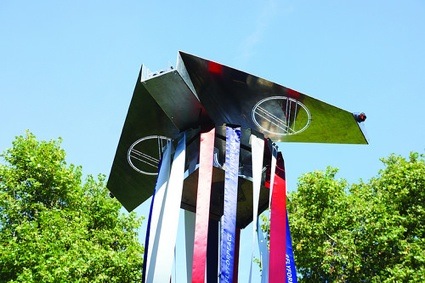 Eizo Ishikawa and Tamon Sawangdee, CRAF, 2014
Eizo Ishikawa and Tamon Sawangdee, CRAF, 2014
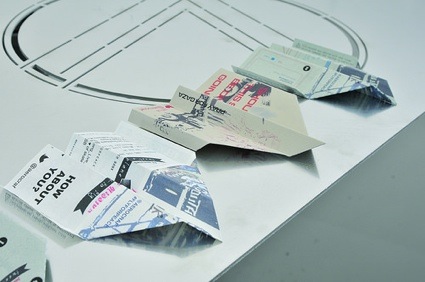 Examples of different themed projectiles
Examples of different themed projectiles
Third (and last) project from the graduation show of The interactive Architecture Lab, a Bartlett School of Architecture research group and Masters Programme headed by Ruairi Glynn, Christopher Leung and William Bondin…
With CRAF, Eizo Ishikawa and Tamon Sawangdee looked at how machines can be deployed to organize spectacles and engage people into performances and new forms of social protests. CRAF turns into paper planes messages of protests that people exchange on social media. Comments and reactions sent to @aerocraf are printed on paper, folded into little projectiles and thrown over passersby by a 6 meter high paper plane-folding machine.
Quick discussion with Tamon Sawangdee:
Hi Tamon! Why did you call the work CRAF? Is it an acronym?
CRAF has many meanings for our project. It came from our first paper plane folding machine project, which was called “AEROCRAFT”. We chose the word “CRAFT” to signify its folding activity and transportation ability. After we have been working on our project for a while, we develop ourselves and our machines into an agency that is called CRAF. Having our ideas rooted from people protesting and looking for ways to express their ideas or feelings, we created CRAF to be the agent that works with people and can act for them. It is an acronym from Cultural Restoration and Acting Facilities.
You tested CRAF on Gordon Square. Can you tell us about the experience? How did people react?
The experience from testing CRAF in Gordon Square was really amazing. We have been working on it for a long time and it was the first time that we got to see it fully equipped and elevated up to 6 metres in the park. The weather was nice and sunny on that day so we got a lot of audience from the people who came in to have lunch, as well as, the ones who were just passing by. Some would come to talk to us about how it worked and what it was, while, most of the people sat around and waited to see the performance. One of the noticeable reaction that we got was the group of people who sat down and asked each other “What is that?” pointing to our machine. People were talking about our project and they were surprised about it being in the center of what was usually very quiet park. We were satisfied about the test in Gordon Square because a lot people showed a lot of interest. It was nice to see people enjoying what we were doing.
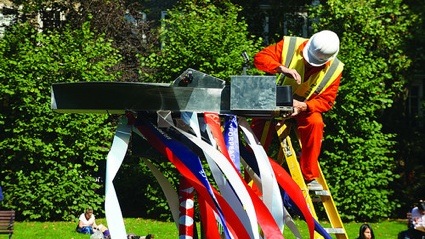 Eizo Ishikawa and Tamon Sawangdee, CRAF, 2014
Eizo Ishikawa and Tamon Sawangdee, CRAF, 2014
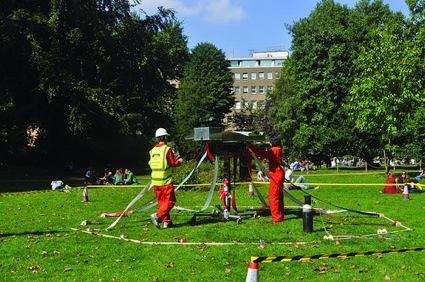 Eizo Ishikawa and Tamon Sawangdee, CRAF, 2014
Eizo Ishikawa and Tamon Sawangdee, CRAF, 2014
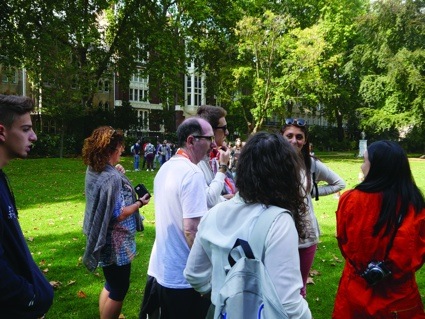 Eizo Ishikawa and Tamon Sawangdee, CRAF, 2014
Eizo Ishikawa and Tamon Sawangdee, CRAF, 2014
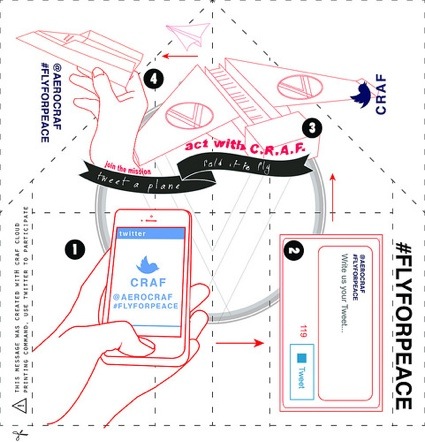 Example of Print Out Invitations to be folded by the machine
Example of Print Out Invitations to be folded by the machine
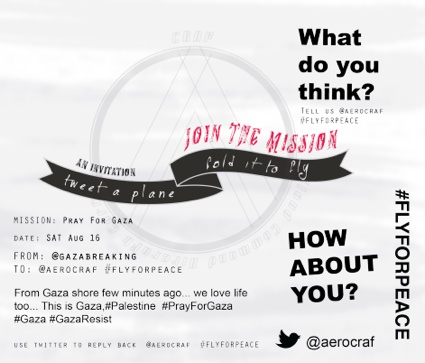 Is there any reason why you selected the colours red white and blue for the ribbons hanging from the machine?
Is there any reason why you selected the colours red white and blue for the ribbons hanging from the machine?
Our theme for CRAF was #FLYFORPEACE, it is a civilian service. Our concerns, are about the political, socio-economical and cultural sustainability aspect of the community. We chose the colour red, white and blue for our prototype because we wanted to give it an appearance of stability, freedom, with a touch of revolution and justice. We wanted our machine to be amicable but not too whimsical, though, at the same time representing the topics of the conversations that we were trying to create. At that time, our machine was representing the Scottish Independence Referendum, if our machine was to perform to represent another message, the colours of the ribbons could change to match that theme.
How does it work? How does the paper get fold into airplanes?
If you tweet to the machines twitter account @aerocraf. The printer would print the message onto the paper plane. When the paper comes out of the printer, it gets fed into the paper plane folding machine, that’s when the folding starts to happen. There are 3 steps of folding. The paper travels through the machine by the use of rollers controlled by motors, chains and sprockets. The machine folds the paper in to a plane by folding the tip of the paper plane first, and then the side wings, the centre of the plane gets fold half until it comes out of the machine. Then, it is ready to launch!
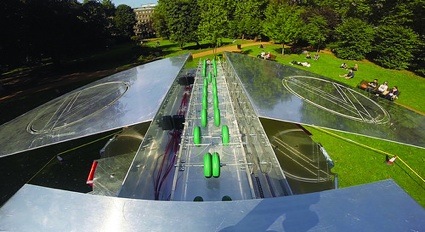 View from CRAF looking down over the park
View from CRAF looking down over the park
And does the machine send the planes in random directions?
The machine can rotate 180 degrees. The rotational movement can vary depending on the site and installation strategies. The print outs and the instructions of how to use the machine comes out in random directions when there are many people. We want the paper planes to be received by the citizens, so, ideally it would have a behavior that looks for people and decide its projectile direction.
What was the biggest challenge you encountered while developing the work?
One of the biggest challenge while developing the work was how to get people to realise that the paper planes that we were flying was containing a message. In order for our project to work smoothly, we needed to get people from the public to work with us. We had a lot of trouble trying to get people to behave accordingly to how we expected, which was to pick up our papers and investigate them and respond our paper planes. Different people in different places would react differently, we had to do many experiments to find our way of delivering the paper airplanes, its flying ability, and what it looks like and how the messages communicate to the people. We also had to design our installation strategy and opening performance to grab the interest from the crowd.
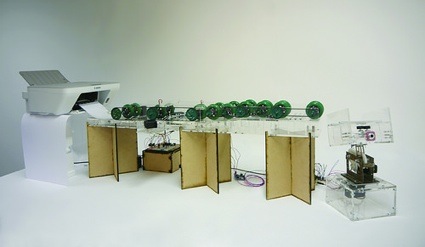
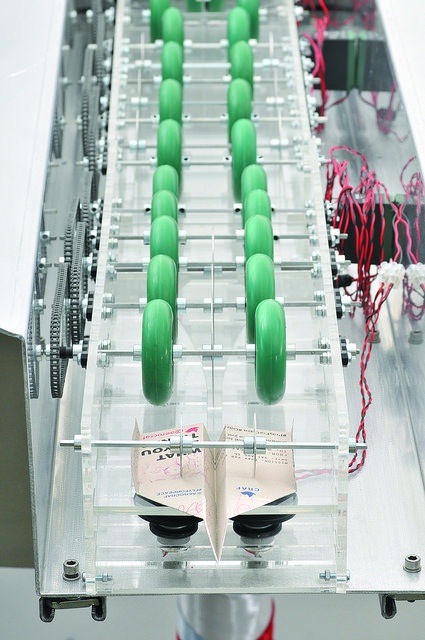 Paper Plane Manufacturing Line Embedded into Aluminium Folded Plane Structure
Paper Plane Manufacturing Line Embedded into Aluminium Folded Plane Structure
The text of the catalogue says “CRAF can be a network of communication platforms along the city by having machine carriers traveling along the existing bike routes of London.” Could you explain how that would work?
CRAF was created to be a communication platform that was initially inspired from the contemporary social crisis and the expressions of dissent happening around our world. We wanted it to be able to serve as a novel communication tactic that people can use to express themselves freely about their ideologies or simply talk to each other via the aid of social media in the hope that it would create a stronger and more culturally sustainable community.
When we were developing CRAF, we were looking for strategies to disseminate our messages and get people involved with the performances. We studied street performances and theatrical machines. We got inspired by how they were able to attract or engage people into live events. Because of that, the idea of using bicycles as a mode for transporting our machines came to our minds — however, we were not limited to just bicycles but tend to see CRAF working rather more of something like a vehicle or a machine integrated within a vehicle. Our machines were designed to be able to travel around and interact with people or get people to interact with each other along its path. In that sense, we think that CRAF can be developed into a system of multiple machines that can be moved or carried around the city.
Making use of social media and the rapid spread of its content via the internet and social networks, we wanted CRAF to become an agency that can be installed into different nodes like the public spaces of London. The communication network coming out from CRAF is imagined to work similar to that of online social network from social media. Instead of only having people interacting in the online space, we wanted to bring people from the online communities out to enjoy the physical environment. When CRAF physicalised online messages into public space, we can have a real human to human interaction. In a way, CRAF is meant to encourage physical social networks happening from the systems machines traveling and sending out messages around its routes.
What is next for CRAF? Are you planning other performances?
At the moment we haven’t been planning any performances.
Eizo is back in Japan and I am now in Thailand. We are both doing different things.
Maybe it can be adapted into something suitable for Bangkok or Tokyo. We’ll see.
Thanks Tamon!
Also from the same Bartlett course: The Eye Catcher and Furl: Soft Pneumatic Pavilion.
